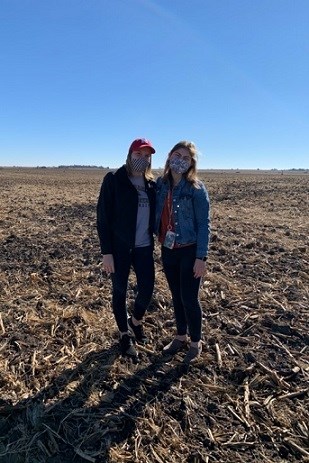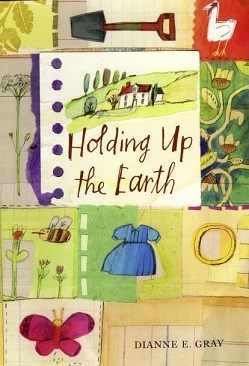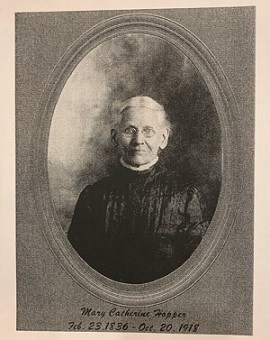Last updated: November 18, 2020
Article
The Incredible Perseverance of the Woman Pioneer

Though the restrictions on female political involvement may overshadow most modern observers’ perceptions, women were a strong driving force in the United States during the eighteenth and nineteenth centuries. In an interview with Anna Palmer Museum (York, NE) temporary curator, Nancy Beach, she said that “women held their families together.” Women persevered through isolation, inequality, and adversities many of us can hardly imagine, building a life for themselves and their families. Phoebe May Hopper, Nebraska Wesleyan University professor from 1901-1938, wrote an unpublished manuscript entitled Little Pioneer’s Parents in 1951 about her family’s homestead in York County, Nebraska. The manuscript portrays the perseverance of women pioneers through Hopper’s mother, Kate. This story is what inspired our group to further research the sedulity of women pioneers, specifically in York County, Nebraska.

Dianne Gray

York County Historical Association and Nancy Beach
“Throughout American history, land ownership has provided individuals and groups with crucial resources and a measure of power, and its denial has both impoverished and disfranchised them.” 6 The Homestead Act of 1862 opened the door for many minorities and suppressed groups including women, African Americans, American Indians, and Latinx. Land was power during the late 1800s and early 1900s. When our group researched the impact of women in York County, we decided to also look at landownership in the York 1889 Atlas, which is available to the public on the York County Historical Association website. What we found was that in 1889, about 5.8% of land in York County was owned by women. Many of these women likely owned land because of inheritance, to act as a marriage dowry, as an old-age pension, and to gain economic freedom and autonomy. 7 About 2% of these women did not have a male with the same last name also owning land in the county. To claim land under the Homestead Act of 1862, you had to be at least 21 years of age, and as a woman, you had to be single, as in, widowed, divorced, never married, or head of household. 8 No matter how or why women obtained land, they gained power by doing so. “Women used land as a resource to exercise power: in establishing cultural autonomy, supporting their economic independence, and facilitating their political participation.” 9

Note from the authors:
Hi! Our names are Abbey Parten, Brooke Lindquist, and Hayley Piippo. We are freshmen at Nebraska Wesleyan University (NWU). For one of our classes, we were tasked with finding ways to share engaging information about women of the past using the unpublished manuscript of NWU 1901-1938 professor, Phoebe May Hopper. This article and The Making of Phoebe May Hopper- Pioneer to Professor, are the results of our research. We hope you enjoy our work and learn a little more about the extraordinary women pioneers that helped shape the world we know today.
[1] Kathleen O'Neal. Gear, “Thin Moon and Cold Mist,” in Thin Moon and Cold Mist (New York, NY: Forge, 1996), 10.
[2] Dianne Gray, video call interview with authors, October 27, 2020.
[3] Phoebe May Hopper, “Little Pioneer’s Parents” (private collection of Jean Bolton, 1951), 45.
[4] Hopper, 45
[5] Hopper, 51
[6] Karen V. Hansen, Grey Osterud, and Valerie Grim, “‘Land Was One of the Greatest Gifts’: Women's Landownership in Dakota Indian, Immigrant Scandinavian, and African American Communities,” Great Plains Quarterly 38, no. 3 (2018): 252, https://doi.org/10.1353/gpq.2018.0041.
[7] Hansen, Osterud, and Grim, 267
[8] Hansen, Osterud, and Grim, 259-260
[9] Hansen, Osterud, and Grim, 265
[10] Greater York Area Centennial Corporation, Greater York Area Centennial, souvenir historical booklet, 1970
[11] Nancy Beach, conversation with authors (P, A, P, H), October 30, 2020
[12] Nancy Beach
[13] Nancy Beach
[14] Nancy Beach
Beach, Nancy. Conversation with authors (P, A, P, H). Anna Palmer Museum and York County. October 30, 2020
Gear, Kathleen O'Neal. “Historical Forward.” Foreword. In Thin Moon and Cold Mist, 9–12. New York, NY: Forge, 1996.
Gray, Dianne. By authors. Homesteading for Women in York County Nebraska. Video-call interview. October 27, 2020.
Greater York Area Centennial Corporation. “Greater York Area Centennial.” Souvenir historical booklet. 1970.
Hansen, Karen V., Grey Osterud, and Valerie Grim. “‘Land Was One of the Greatest Gifts’: Women's Landownership in Dakota Indian, Immigrant Scandinavian, and African American Communities.” Great Plains Quarterly 38, no. 3 (2018): 251–72. https://doi.org/10.1353/gpq.2018.0041.
Hopper, Phoebe May. “Little Pioneer’s Parents.” Private collection of Jean Bolton. 1951.
